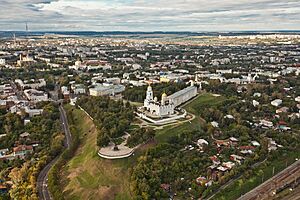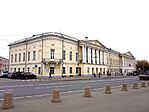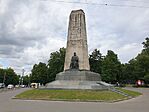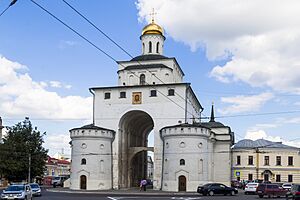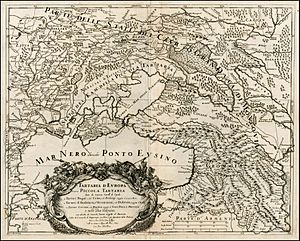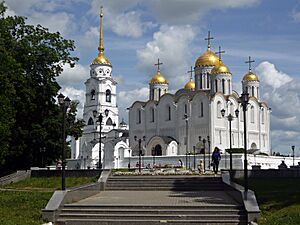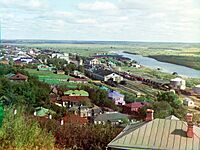Vladimir, Russia facts for kids
Quick facts for kids Vladimir (English)Владимир (Russian) |
|
|---|---|
| - City - | |
| [[File:
|250px]] From top to bottom, from left to right: Assumption Cathedral from a bird's eye view, Trinity Church, Vladimir Academic Drama Theater, Center for Culture and Art on Sobornaya, Monument to the 850th anniversary of the city of Vladimir, Golden Gate. |
|
|
|
|
| City Day | The first Sunday of September |
| Administrative status | |
| Country | Russia |
| Federal subject | Vladimir Oblast |
| Administratively subordinated to | City of Vladimir |
| Municipal status | |
| Urban okrug | Vladimir Urban Okrug |
| Administrative center of | Vladimir Urban Okrug |
| Head | Dmitry Naumov |
| Representative body | Council of People's Deputies |
| Statistics | |
| Area | 124.59 km2 (48.10 sq mi) |
| Population (2010 Census, preliminary) |
345,373 inhabitants |
| - Rank in 2010 | 51st |
| Density | 2,772/km2 (7,179/sq mi) |
| Time zone | MSK (UTC+04:00) |
| First mentioned | 990 |
| Postal code(s) | 600000, 600001, 600003, 600005–600009, 600014–600018, 600020–600028, 600031–600033, 600035–600038, 600700, 600950, 600960, 600970, 600980, 600999, 992800 |
| Dialing code(s) | +7 4922 |
| Official website: http://www.vladimir-city.ru | |
Vladimir (Russian: Влади́мир) is a city in Russia. It is the main city of Vladimir Oblast. Vladimir is located on the Klyazma River, about 200 kilometers (124 miles) east of Moscow. You can reach it by train and the M7 motorway. In 2021, its population was around 349,951 people.
Contents
- History of Vladimir: A Journey Through Time
- Population of Vladimir
- Economy and Military in Vladimir
- Transportation: Getting Around Vladimir
- Climate in Vladimir
- Sightseeing: Explore Vladimir's Historic Sites
- Education in Vladimir
- Sports in Vladimir
- Twin Towns and Sister Cities
- Notable People from Vladimir
History of Vladimir: A Journey Through Time
Vladimir was once one of the most important cities in medieval Russia. Many amazing buildings from the 12th century still stand today. Two of its cathedrals and a monastery are part of the White Monuments of Vladimir and Suzdal, a UNESCO World Heritage Site. In the past, the city was also called Vladimir-on-Klyazma or Vladimir-Zalessky. This helped people tell it apart from another city named Vladimir in what is now Ukraine.
When Was Vladimir Founded?
The exact year Vladimir was founded is a bit of a mystery! Some people think it was in 990, while others say 1108.
The Novgorod First Chronicle first mentions Vladimir in 1108. During the Soviet era, this year was chosen as the founding date. They believed the city got its name from Vladimir II Monomakh, who became ruler of the Rostov-Suzdal Principality in 1093. Old writings also describe Vladimir as a "young town" compared to nearby Suzdal and Rostov. Because of this, Vladimir celebrated its 850th anniversary in 1958.
However, in the 1990s, a new idea came up. Many local historians now believe the city was founded in 990 by Vladimir the Great. They found old texts that suggest Vladimir the Great, who helped bring Orthodoxy to Russia, visited the area in 990. Today, the city's official law, the Charter of Vladimir (passed in 2005), states 990 as the founding year.
Vladimir's Golden Age: The Vladimir-Suzdal Principality
Vladimir became truly important after the 12th century. At first, it was just a small fort protecting the Rostov-Suzdal Principality. It didn't have much power when Vladimir Monomakh (1113–1125) or his son Yury Dolgoruky (1154–1157) ruled.
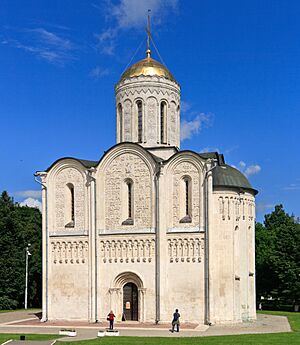
Under Yury Dolgoruky's son, Andrey Bogolyubsky (1157–1175), Vladimir became the main city of the Vladimir-Suzdal Principality. This was Vladimir's "Golden Age," a time of great growth and wealth that lasted until the Mongol invasion of Rus' in 1237. Andrey built the city's famous Golden Gates and the Dormition Cathedral.
Many Russian, German, and Georgian builders worked on Vladimir's beautiful white stone cathedrals, monasteries, and palaces. Their outsides were covered with detailed stone carvings. Only three of these amazing buildings are still standing: the Dormition Cathedral, the Cathedral of Saint Demetrius, and the Golden Gate. They are all part of the White Monuments of Vladimir and Suzdal, a UNESCO World Heritage Site.
Andrey also built a royal palace in Bogolyubovo and the famous Church of the Intercession on the Nerl. This church is considered one of the most beautiful examples of old Russian architecture. Andrey was sadly killed at his palace in 1175.
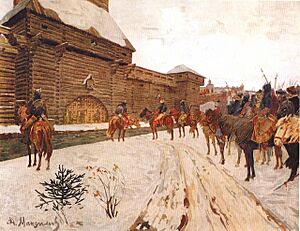
Vladimir faced a terrible attack by the Mongol-Tatars of the Golden Horde in 1238. The city was taken on February 8, 1238. A huge fire destroyed many buildings, and the grand prince's family died in a church where they tried to hide. The grand prince escaped but was killed later that month.
Vladimir and the Rise of Moscow
After the Mongol invasion, Vladimir never fully recovered its former glory. The most important Russian prince, usually the Prince of Moscow, was called the Grand Prince of Vladimir. But this title became more of an honor than a real power. From 1299 to 1325, Vladimir was home to the main church leaders of Russia. However, in 1325, Metropolitan Peter moved the main church office to Moscow.
Grand Princes were first crowned in Vladimir's Assumption Cathedral. But once Moscow became the most powerful city in the 14th century, they started having their coronations in the Assumption Cathedral in the Moscow Kremlin. This Moscow cathedral was even designed to look like Vladimir's original one.
Even after Moscow became the capital, Grand Princes of Moscow continued to build new churches in Vladimir. Examples include the Annunciation Church at Snovitsy (around 1501) and a church in the Knyaginin Nunnery (around 1505). This nunnery church still has murals from 1648.
Vladimir in Imperial Russia
The remains of the prince-saint Alexander Nevsky were kept in Vladimir until 1703. Then, Peter the Great moved them to a monastery in St. Petersburg.
In 1778, Vladimir became the center of a new region called the Vladimir Viceroyalty. Later, in 1796, it became the Vladimir Governorate.
Important changes came to Vladimir in the 1800s. In December 1858, the city got its first telegraph service. On June 14, 1861, a railway line opened, connecting Vladimir to Moscow and Nizhny Novgorod. Running water arrived in 1866, telephone lines in 1887, and the first electric power lines in 1908.
Vladimir in the Soviet Union
After the Soviet government took power, many streets in Vladimir were renamed. Most of the old churches were closed or even torn down.
In the early Soviet years, Vladimir became more industrial. On January 14, 1929, the Vladimir Governorate was ended. The city became part of a larger industrial region.
On August 14, 1944, Vladimir became the main city of the new Vladimir Oblast. In 1950, a teachers' college was created. On November 5, 1952, the first trolleybus line started running in the city.
In 1958, the Vladimir–Suzdal Museum and Reserve was created. This museum protects many unique old buildings and monuments in Vladimir, Suzdal, and other nearby villages.
Buildings from the Soviet period include the Torpedo Stadium (built 1952), a large bridge over the Klyazma River (1960), the Hotel Vladimir (1956), and the Drama Theatre (1971). In 1971, the city received an award called the Order of Red Banner of Labor.
Population of Vladimir
| Historical population | ||
|---|---|---|
| Year | Pop. | ±% |
| 1897 | 28,479 | — |
| 1926 | 37,004 | +29.9% |
| 1939 | 66,797 | +80.5% |
| 1959 | 153,895 | +130.4% |
| 1970 | 234,087 | +52.1% |
| 1979 | 296,371 | +26.6% |
| 1989 | 349,702 | +18.0% |
| 2002 | 315,954 | −9.7% |
| 2010 | 345,373 | +9.3% |
| 2021 | 349,951 | +1.3% |
| Source: Census data | ||
The population of Vladimir has grown a lot over the years. Here's how it has changed: 345,373 (2010 Census); 315,954 (2002 Census); 349,702 (1989 Census).
Economy and Military in Vladimir
Vladimir has several factories that make electrical and chemical products. It also has food processing plants and two large power stations. Tourism is a big part of the city's economy because of its many historical sites.
The city is also home to a military headquarters for rocket troops. During the Cold War, Vladimir had an air force base called Dobrynskoye.
Transportation: Getting Around Vladimir
Vladimir has been connected to Moscow by railway since 1861. The M7 highway also links Vladimir to Moscow and Nizhny Novgorod. Inside the city, you can get around using buses, trolleybuses, minivans, and taxis.
Vladimir's bus service connects the city to all the towns in Vladimir Oblast. You can also take buses to other cities like Moscow, Ivanovo, Kostroma, Nizhny Novgorod, Ryazan, and Yaroslavl.
Many long-distance trains pass through Vladimir station every day. This means Vladimir has direct train links all year round to Moscow, St. Petersburg, and Nizhny Novgorod. Since 2010, the "Peregrine Falcon" high-speed train also stops in Vladimir.
The city also has a good local train system for nearby areas. Vladimir is served by the Semyazino Airport, which is about 5 kilometers (3 miles) west of the city center.
Transportation Gallery
Climate in Vladimir
Vladimir has a humid continental climate. This means it has long, cold winters and short, warm summers.
| Climate data for Vladimir (1991–2020, extremes 1902–present) | |||||||||||||
|---|---|---|---|---|---|---|---|---|---|---|---|---|---|
| Month | Jan | Feb | Mar | Apr | May | Jun | Jul | Aug | Sep | Oct | Nov | Dec | Year |
| Record high °C (°F) | 7.1 (44.8) |
9.5 (49.1) |
17.8 (64.0) |
27.8 (82.0) |
34.0 (93.2) |
35.2 (95.4) |
37.1 (98.8) |
36.5 (97.7) |
29.5 (85.1) |
25.0 (77.0) |
17.8 (64.0) |
12.0 (53.6) |
37.1 (98.8) |
| Mean daily maximum °C (°F) | −5.5 (22.1) |
−4.4 (24.1) |
1.8 (35.2) |
11.1 (52.0) |
19.1 (66.4) |
22.2 (72.0) |
24.6 (76.3) |
22.6 (72.7) |
16.3 (61.3) |
8.2 (46.8) |
0.3 (32.5) |
−3.8 (25.2) |
9.4 (48.9) |
| Daily mean °C (°F) | −8.3 (17.1) |
−7.7 (18.1) |
−2.3 (27.9) |
5.8 (42.4) |
13.0 (55.4) |
16.6 (61.9) |
19.0 (66.2) |
16.9 (62.4) |
11.4 (52.5) |
4.9 (40.8) |
−1.9 (28.6) |
−6.1 (21.0) |
5.1 (41.2) |
| Mean daily minimum °C (°F) | −10.9 (12.4) |
−10.6 (12.9) |
−5.6 (21.9) |
1.4 (34.5) |
7.7 (45.9) |
11.7 (53.1) |
14.1 (57.4) |
12.3 (54.1) |
7.7 (45.9) |
2.4 (36.3) |
−3.8 (25.2) |
−8.4 (16.9) |
1.5 (34.7) |
| Record low °C (°F) | −39.7 (−39.5) |
−36.1 (−33.0) |
−30.0 (−22.0) |
−16.1 (3.0) |
−8.0 (17.6) |
−0.1 (31.8) |
3.9 (39.0) |
0.0 (32.0) |
−6.3 (20.7) |
−18.9 (−2.0) |
−27.2 (−17.0) |
−43.0 (−45.4) |
−43.0 (−45.4) |
| Average precipitation mm (inches) | 40 (1.6) |
33 (1.3) |
29 (1.1) |
36 (1.4) |
46 (1.8) |
71 (2.8) |
65 (2.6) |
54 (2.1) |
50 (2.0) |
55 (2.2) |
45 (1.8) |
39 (1.5) |
563 (22.2) |
| Average extreme snow depth cm (inches) | 28 (11) |
41 (16) |
35 (14) |
5 (2.0) |
0 (0) |
0 (0) |
0 (0) |
0 (0) |
0 (0) |
0 (0) |
6 (2.4) |
17 (6.7) |
41 (16) |
| Average rainy days | 5 | 3 | 6 | 12 | 15 | 17 | 15 | 15 | 16 | 16 | 10 | 5 | 135 |
| Average snowy days | 26 | 23 | 16 | 6 | 1 | 0 | 0 | 0 | 1 | 6 | 18 | 25 | 122 |
| Average relative humidity (%) | 86 | 82 | 76 | 71 | 67 | 73 | 76 | 79 | 82 | 85 | 88 | 87 | 79 |
| Source: Pogoda.ru.net | |||||||||||||
Sightseeing: Explore Vladimir's Historic Sites
Modern-day Vladimir is a popular place for tourists. It's part of the Golden Ring of Russia, a group of ancient Russian cities. Three of its most important monuments are on the UNESCO World Heritage List. They are:
- The amazing five-domed Dormition Cathedral. This cathedral was built to be the burial place for grand princes. It was built between 1158 and 1160, and made larger from 1185 to 1189. Famous artists Andrei Rublev and Daniil Chyorny painted its walls in 1408. A tall bell-tower was added in 1810.
- The Cathedral of Saint Demetrius. This cathedral, with its helmet-shaped dome, was built from 1194 to 1197. It was a private chapel for Prince Vsevolod the Big Nest. The cathedral shows a mix of Russian and Byzantine styles, with help from German and Georgian builders.
- The Golden Gate. This was originally a tower over the city's main entrance, built from 1158 to 1164. It was rebuilt in the late 1700s to keep it from falling down.
You can find other remarkable old Russian buildings nearby. Check out Suzdal, Yuriev-Polsky, Bogolyubovo, and Kideksha for more information.
Sightseeing Gallery
Education in Vladimir
Vladimir has many schools and colleges. Here are some of the main ones:
- Vladimir State University
- Vladimir branch of the Russian Academy of National Economy and Public Administration
- Vladimir branch of Financial University under the Government of the Russian Federation
- Vladimir branch of the Russian University of Cooperation
- Vladimir Law Institute under the Ministry of Justice
- Vladimir Business Institute
- Vladimir Aviation Mechanics College
- Vladimir Pedagogical College
- Vladimir Polytechnic College
- Vladimir Basic Medical College
- Vladimir Construction College
- Vladimir Regional College of Music
- Vladimir Economy and Technology College
- Vladimir College of Technology
- Vladimir Industrial College
- Vladimir Chemical and Mechanical College
- College of Innovative Technologies and Entrepreneurship at Vladimir State University
Vladimir is also home to the Federal Centre for Animal Health and Welfare.
Sports in Vladimir
Vladimir has a football team called FC Torpedo Vladimir. They play in the second tier of Russian football.
The city also has a volleyball team, Vladimir VC. There's also a hockey club, Polaris-Vladimir, and a table-tennis club called Luch.
Twin Towns and Sister Cities
Vladimir has "twin town" or "sister city" relationships with many cities around the world. This means they share culture and friendship.
 Anghiari, Italy
Anghiari, Italy Antalya, Turkey
Antalya, Turkey Babruysk, Belarus
Babruysk, Belarus Baoji, China
Baoji, China Bloomington, United States
Bloomington, United States Bukhara, Uzbekistan
Bukhara, Uzbekistan Campobasso, Italy
Campobasso, Italy Canterbury, United Kingdom
Canterbury, United Kingdom Chongqing, China
Chongqing, China Erlangen, Germany
Erlangen, Germany Gagra, Georgia
Gagra, Georgia Haikou, China
Haikou, China Kardzhali, Bulgaria
Kardzhali, Bulgaria Karlovo, Bulgaria
Karlovo, Bulgaria Kerava, Finland
Kerava, Finland Khujand, Tajikistan
Khujand, Tajikistan Leninsky (Minsk), Belarus
Leninsky (Minsk), Belarus Normal, United States
Normal, United States Saintes, France
Saintes, France Sarasota, United States
Sarasota, United States Skive, Denmark
Skive, Denmark Vawkavysk, Belarus
Vawkavysk, Belarus
- Former twin towns
Some twin town relationships were ended in 2022 because of the Russian invasion of Ukraine:
 Jelenia Góra, Poland
Jelenia Góra, Poland Ústí nad Labem, Czech Republic
Ústí nad Labem, Czech Republic
Notable People from Vladimir
Many famous people were born in or lived in Vladimir, including:
- Valentin Afonin, a football player
- Yuri Lodigin, a football player
- Nikolai Andrianov, a gymnast
- Vladimir Artemov, a gymnast
- Aleksey Batalov, an actor
- Mikhail Lazarev, an admiral
- Yuri Levitan, a radio announcer
- Anna Loginova, a fashion model
- Alexey Prokurorov, a cross-country skier
- Yuri Ryazanov, a gymnast
- Vasily Shulgin, a politician
- Mikhail Speransky, a statesman
- Aleksandr Stoletov, a physicist
- Nikolai Stoletov, a general
- Sergei Taneyev, a composer
- Dmitri Vyazmikin, a football player
- Venedikt Yerofeyev, a writer
- Denis Yevsikov, a football player
- Nikolay Zhukovsky, a scientist


